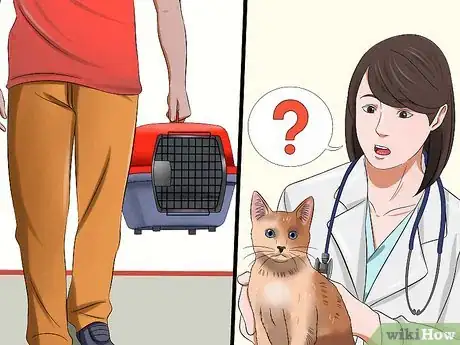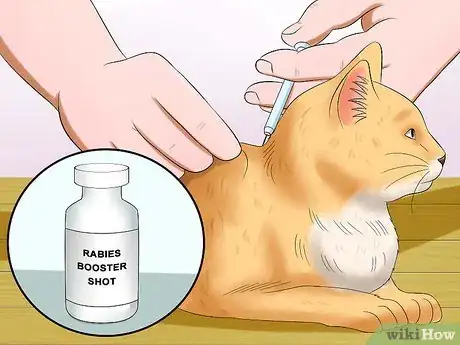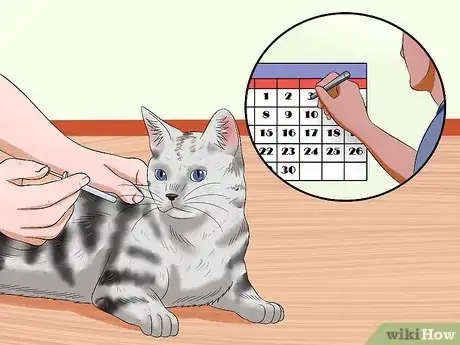This article was co-authored by Pippa Elliott, MRCVS. Dr. Elliott, BVMS, MRCVS is a veterinarian with over 30 years of experience in veterinary surgery and companion animal practice. She graduated from the University of Glasgow in 1987 with a degree in veterinary medicine and surgery. She has worked at the same animal clinic in her hometown for over 20 years.
There are 8 references cited in this article, which can be found at the bottom of the page.
wikiHow marks an article as reader-approved once it receives enough positive feedback. In this case, 89% of readers who voted found the article helpful, earning it our reader-approved status.
This article has been viewed 307,668 times.
There are a few cases of cat rabies in the United States every year.[1] This happens because some cats are not vaccinated or their vaccines lapse and they come into contact with a rabid wild animal. If you come in contact with a cat you suspect might have rabies, there are certain signs of the disease that you can look for in the animal. Always use extreme caution around a cat you think may be infected with rabies and do not attempt to capture a cat that seems rabid. Contact animal control, a local wildlife group, or call the police on their non-emergency line.
Steps
Detecting Signs of Rabies
-
1Watch for early signs of rabies. The early stage of rabies can last from two to ten days. During this time, the cat will seem sick with non-specific symptoms. Early non-specific signs of rabies include:[2]
- muscle pain
- restlessness
- irritability
- chills
- fever
- malaise, which is a general feeling of sickness and discomfort
- photophobia, which is a fear of bright lights
- anorexia, or a disinterest in food
- vomiting
- diarrhea
- cough
- inability or unwillingness to swallow
-
2Inspect your cat for bites or signs of a fight. If you think your cat might have come in contact with a rabid animal, check to see if he has any bite marks or signs of a fight. The rabies virus can live on the cat’s skin or hair for up to two hours, so wear gloves and a long-sleeved shirt and pants before handling the cat. When an infected animal bites another animal, the infected animal’s saliva may transmit rabies to the healthy animal. Once the disease enters the body, it travels via the nerves to the spinal cord and brain.[3] Take your cat to a veterinarian right away if you notice any:
- bite marks
- scabs
- scratches
- ruffled fur with dried saliva
- abscesses
Advertisement -
3Look for signs of “dumb” or paralytic rabies. The dumb form of rabies the most common form of rabies in cats. A cat suffering from dumb form rabies will seem lethargic, confused, and sick.[4] In this form of rabies, cats are not vicious and rarely attempt to bite. Symptoms of dumb or paralytic rabies include:[5]
- paralysis (inability to move) of the legs, facial muscles, or other parts of the body
- dropping of the lower jaw, leading to a “dumb” look.
- excess salivation that creates a foam around the mouth
- difficulty swallowing
-
4Be extra cautious if a cat has furious symptoms of rabies. Cats with the furious form of rabies are often aggressive, display abnormal behavior, and will foam around the mouth. Most people think of these behaviors when they think of rabies, but the furious form of rabies is less common in cats than the paralytic form. Call animal control to assist you if you think a cat is suffering from the furious form of rabies. A cat with furious form rabies will attack, so do not attempt to capture the cat on your own. Signs of furious form rabies include:[6]
- profuse salivation that looks like foam around the cat’s mouth
- hydrophobia, seeming afraid to go near water or frightened by the sound of water
- aggression, such as baring teeth as if ready to bite
- restlessness
- disinterest in food
- biting or attacking
- abnormal behavior, such as chewing on its own body
Treating a Rabid Cat
-
1Call animal control if you spot a cat that seems infected. Do not attempt to capture a rabid cat on your own. If you see signs that a cat might be infected, it is best to call animal control. This way the cat can be taken to a veterinarian without putting you at risk for a bite.
- You should also contact animal control if your cat is behaving strangely or aggressively.[7]
-
2Take your cat to see a veterinarian. If your cat has been bitten by a cat or some other animal, place him in a carrier and bring him to a veterinarian as soon as possible.[8] The veterinarian will ask you questions about possible rabies exposure (recent smell of skunk in your yard, exposure to raccoons, any bats in the area) and examine your cat.
- Keep in mind that there is no live animal test to determine whether or not an animal has rabies. The brain has to be removed from the body. To make a rabies diagnosis, small sections of the brain will be examined under a microscope to look for the presence of Negri bodies.
-
3Request a rabies booster shot for your cat. If your cat has been previously vaccinated against rabies, he will have a booster shot of the vaccine as soon as possible after he is bitten. This will help his immune system fight off the virus. He will also have to be observed for signs of rabies for 45 days. This can often be done at home as long as your cat will be confined and will not have any contact with any animals or humans outside of the household.
-
4Be aware that euthanasia may be necessary. If a cat has not been vaccinated against rabies and is bitten by a confirmed rabid animal, euthanasia is often recommended.[9] This is because rabies is a serious threat to human health and there is a high chance that the cat will become rabid.
- If the owner refuses to euthanize the cat, then it will need to be quarantined and observed for six months. This quarantine must take place at a veterinary clinic at the owner’s cost.
- If the cat does not succumb to rabies during this time, then he will be allowed to come home. He will just need to have a rabies vaccine one month before release.
Protecting Your Cat from Rabies
-
1Make sure that your cat is up to date on vaccinations. Getting your cat vaccinated against rabies is the best, most cost-effective way to prevent this disease. In many countries, rabies vaccinations are required by law.
- Set up a regular vaccination schedule with your veterinarian to keep your cat’s rabies vaccine up-to-date. Some vaccines need to be administered yearly, every two years, or every three years.[10]
-
2Keep your cat inside. Another way to protect your cat from rabies is to keep him from away from wild animals. Keeping your cat in the house is ideal because your cat will not be exposed to neighborhood cats, raccoons, or other animals that might be carrying rabies.
- If your cat is accustomed to going outside, then only allow him outside under your close watch. Don’t let your cat go near any unfamiliar animals.[11]
-
3Discourage wild animals from coming into your yard. Wild animals are common carriers of rabies. If your yard is not appealing to wild animals, then there will be less of a chance of your cat coming into contact with rabid animals. Some things that you can do to keep wild animals out of your yard include:[12]
- placing tight lids on all of your garbage cans
- making sure there are no hiding spots for skunks or raccoons, such as under your deck or house
- putting in a fence to keep wandering animals out of your yard
- keeping trees and shrubs pruned
Expert Q&A
Did you know you can get premium answers for this article?
Unlock premium answers by supporting wikiHow
-
QuestionCan you get rabies from a cat scratch?
 Pippa Elliott, MRCVSDr. Elliott, BVMS, MRCVS is a veterinarian with over 30 years of experience in veterinary surgery and companion animal practice. She graduated from the University of Glasgow in 1987 with a degree in veterinary medicine and surgery. She has worked at the same animal clinic in her hometown for over 20 years.
Pippa Elliott, MRCVSDr. Elliott, BVMS, MRCVS is a veterinarian with over 30 years of experience in veterinary surgery and companion animal practice. She graduated from the University of Glasgow in 1987 with a degree in veterinary medicine and surgery. She has worked at the same animal clinic in her hometown for over 20 years.
Veterinarian
-
QuestionHow long does it take to show symptoms of rabies in a cat?
 Pippa Elliott, MRCVSDr. Elliott, BVMS, MRCVS is a veterinarian with over 30 years of experience in veterinary surgery and companion animal practice. She graduated from the University of Glasgow in 1987 with a degree in veterinary medicine and surgery. She has worked at the same animal clinic in her hometown for over 20 years.
Pippa Elliott, MRCVSDr. Elliott, BVMS, MRCVS is a veterinarian with over 30 years of experience in veterinary surgery and companion animal practice. She graduated from the University of Glasgow in 1987 with a degree in veterinary medicine and surgery. She has worked at the same animal clinic in her hometown for over 20 years.
Veterinarian
-
QuestionCan a cat bite give you rabies?
 Pippa Elliott, MRCVSDr. Elliott, BVMS, MRCVS is a veterinarian with over 30 years of experience in veterinary surgery and companion animal practice. She graduated from the University of Glasgow in 1987 with a degree in veterinary medicine and surgery. She has worked at the same animal clinic in her hometown for over 20 years.
Pippa Elliott, MRCVSDr. Elliott, BVMS, MRCVS is a veterinarian with over 30 years of experience in veterinary surgery and companion animal practice. She graduated from the University of Glasgow in 1987 with a degree in veterinary medicine and surgery. She has worked at the same animal clinic in her hometown for over 20 years.
Veterinarian
Warnings
- Treat any bite wound by washing with soap and water and contact your doctor even if you don’t think the animal has rabies. Bites can become seriously infected with bacteria if not treated right away.[13]⧼thumbs_response⧽
- Be extra cautious around bats, raccoons, skunks, and foxes. These are the most common carriers of rabies in the US.[14]⧼thumbs_response⧽
- Leave wild animals alone! This includes baby animals. Even baby animals can carry rabies. If you find some baby animals that appear to have been abandoned by the mother, then call animal control or a wildlife center and ask them to take care of the animals.[15]⧼thumbs_response⧽
References
- ↑ http://www.cdc.gov/features/dsrabies/
- ↑ Kahn, C, (2010), Merck Veterinary Manual, ISBN 978-0911910933
- ↑ http://www.ncbi.nlm.nih.gov/pubmed/15962654
- ↑ Kahn, C, (2010), Merck Veterinary Manual, ISBN 978-0911910933
- ↑ http://www.ncbi.nlm.nih.gov/pubmed/18365035
- ↑ http://www.ncbi.nlm.nih.gov/pubmed/19965838
- ↑ http://www.petmd.com/cat/conditions/neurological/c_ct_rabies#
- ↑ http://www.petmd.com/cat/conditions/neurological/c_ct_rabies#
- ↑ http://www.petmd.com/cat/conditions/neurological/c_ct_rabies#
- ↑ https://www.aspca.org/pet-care/cat-care/rabies
- ↑ http://www.americanhumane.org/animals/adoption-pet-care/caring-for-your-pet/rabies-facts-tips.html
- ↑ http://www.americanhumane.org/animals/adoption-pet-care/caring-for-your-pet/rabies-facts-tips.html
- ↑ http://www.americanhumane.org/animals/adoption-pet-care/caring-for-your-pet/rabies-facts-tips.html
- ↑ http://www.americanhumane.org/animals/adoption-pet-care/caring-for-your-pet/rabies-facts-tips.html
- ↑ http://www.americanhumane.org/animals/adoption-pet-care/caring-for-your-pet/rabies-facts-tips.html
About This Article
To tell if a cat has rabies, keep an eye out for common early signs, like irritability, fever, vomiting, diarrhea, loss of appetite, and inability to swallow. If you suspect your cat has rabies, inspect it for bite marks or signs of a fight since fighting with a rabid animal is often how cats contract the disease. However, be extra cautious if your cat is foaming at the mouth and acting aggressive, as these are signs that it has furious form of rabies. If you think your cat has furious form of rabies, contact animal control for assistance. To learn how to treat a rabid cat with the help of animal control and a vet, scroll down!




















-Step-18.webp)
-Step-12.webp)



















































